Ford Mustang (1999-2004) Service Manual: Removal
CAUTION: Since the engine is not free-wheeling, if the crankshaft or the camshafts are moved in any manner during removal and installation, the crankshaft and the camshafts must be re-synchronized.
1. Remove the engine front cover. For additional information, refer to Engine Front Cover in this section.
2. Remove the crankshaft sensor ring from the crankshaft.
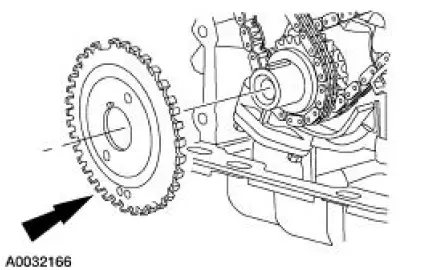
3. CAUTION: Unless otherwise instructed, at no time when the timing chains are removed and the cylinder heads are installed is the crankshaft or the camshaft to be rotated. Severe piston and valve damage will occur.
Using the special tool, position the crankshaft as shown.
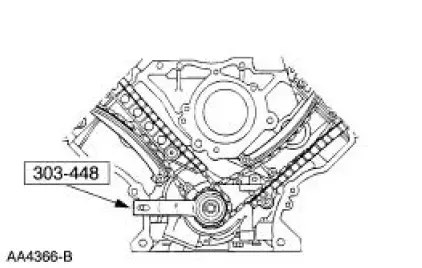
4. CAUTION: The camshaft timing marks must be correctly lined up or damage to the valves and pistons can occur.
NOTE: The copper links on the timing chain may not line up with the timing marks on the sprockets.
Make sure the timing marks on the camshaft sprockets are correctly positioned. If necessary, turn the crankshaft one full turn clockwise to correctly position the sprockets.
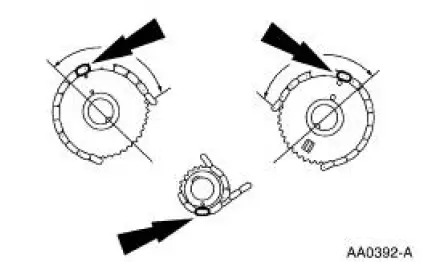
5. NOTE: LH shown; RH similar.
Remove the two bolts, the timing chain tensioner and tensioner arm.
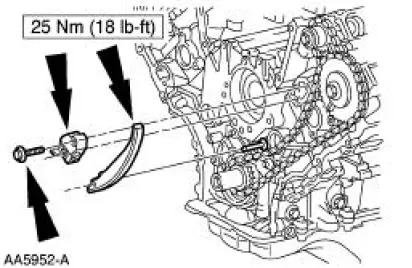
6. CAUTION: Unless otherwise instructed, at no time when the timing chains are removed and the cylinder heads are installed is the crankshaft or the camshaft to be rotated. Severe piston and valve damage will occur.
Remove the LH and RH timing chains and the crankshaft sprocket.
Remove the special tool from the crankshaft.
- Remove the RH timing chain from camshaft sprocket.
- Remove the RH timing chain from the crankshaft sprocket.
- Remove the LH timing chain from the camshaft sprocket.
- Remove the LH timing chain and the crankshaft sprocket.
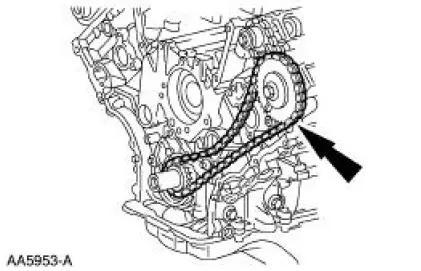
7. CAUTION: The bolts are different lengths and must be returned to their original location.
NOTE: RH shown; LH similar.
Remove the bolts and the timing chain guides.
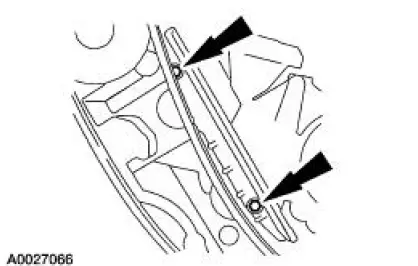
 Timing Drive Components
Timing Drive Components
Special Tool(s)
Holding Tool, Crankshaft
303-448 (T93P-6303-A)
...
 Installation
Installation
1. CAUTION: Timing chain procedures must be followed exactly or damage
to the
pistons or valves will result.
Compress the tensioner plunger, using a soft-jawed vise.
2. Install a retaining clip on ...
Other materials:
Evaporative Emissions (Description and Operation)
Component Location
The evaporative emission system:
is equipped with an on-board refueling vapor recovery (ORVR) system.
prevents hydrocarbon emissions from reaching the atmosphere.
stores fuel vapors in the evaporative emission (EVAP) canis ...
Installation
Using special tool 205-054
NOTE: This is the preferred method for installing the pinion bearing
cups. If necessary, proceed to
Using special tools 205-153, 205-054, and 205-D055 in this procedure for an
alternate method.
1. Position the special tools and th ...
Key Programming - Program a Key Using Two
Programmed Keys
Special Tool(s)
Worldwide Diagnostic System
(WDS)
418-F224,
New Generation STAR (NGS)
Tester
418-F052, or equivalent
diagnostic tool
NOTE: This procedure only works if two or more programmed ignition keys are
available and it is
desi ...
